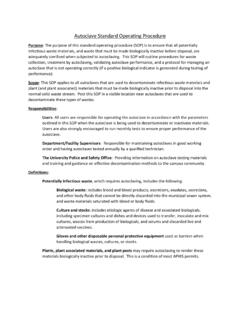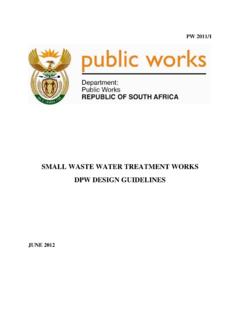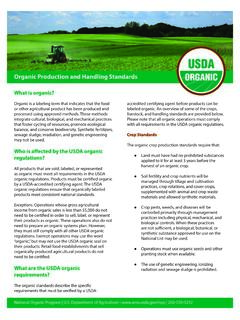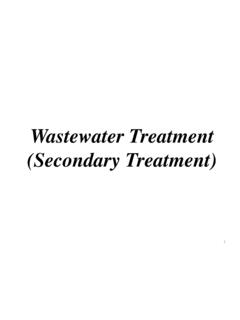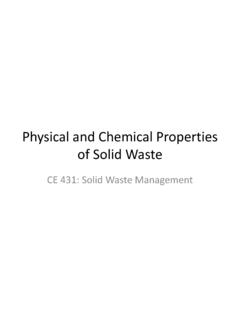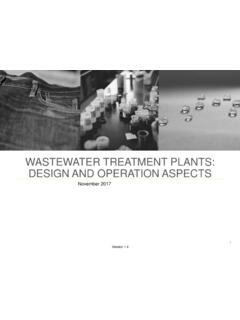Transcription of 3 Municipal Wastewater and Sludge Treatment
1 3 Municipal Wastewater and Sludge TreatmentAt Municipal Wastewater Treatment plants in the United States, raw Municipal wastewaterundergoes preliminary, primary, secondary, and in some cases, additional Treatment to yield treatedeffluent and a concentrated stream of solids in liquid, called Sludge . The Sludge is treated as requiredfor utilization or disposal, and additional Treatment of effluent may be needed to accommodate specificwater reuse practice of Municipal Wastewater Treatment evolved primarily to accommodate dis-chargeof treated effluent to surface waters, not to facilitate use of effluent on crops (see Chapter 2).
2 Becausemunicipal Wastewater Treatment techniques are well established in the United States and becauseeffluent from some Municipal Wastewater Treatment facilities is discharged both to surface water andused to irrigate agricultural land, secondary or higher levels of Wastewater Treatment typically precedewastewater reuse in agriculture in the United States. The relationship of Municipal Wastewater and Sludge Treatment to crop production is shownschematically in Figure As illustrated, reuse of Wastewater for food crop production or in otherreuse applications, such as ground water recharge or urban landscape irrigation, typically occurs aftersecondary Wastewater Treatment and may necessitate additional Treatment .
3 Treatment to producereclaimed water often adds coagulation, filtration, and disinfection to secondary Treatment . Figure illustrates the origin and Treatment of Municipal Wastewater sludges applied to cropland. Following Treatment , sludges may be disposed of (for example, in a landfill) or used for food cropproduction or in other applications (such as silviculture and nonfood crop agriculture).This chapter briefly reviews typical amounts and properties of treated effluent and Sludge , thenexamines processes used in conventional Wastewater Treatment (defined as preliminary, primary, andsecondary Treatment ), processes intended specifically to accommodate Wastewater application to crops,and typical Sludge Treatment AND QUALITY OF MUNICIPALWASTEWATER EFFLUENT AND SLUDGEM unicipal Wastewater represents the spent water supply of communities.
4 In 1990, aver-4546 The Use of Reclaimed water and Sludge in Food Crop ProductionFIGURE Following conventional Wastewater Treatment (preliminary, primary, and secondary), municipalwastewater is discharged to surface waters or reused, or before discharge to surface waters (not illustrated). Additional Treatment may be needed before reuse. Sludge from Wastewater Treatment processes are treated andthen disposed or reused in crop production or other per capita usage from public water supply systems in the United States was 184 gallons (700 liters)per day (Solley et al.)
5 , 1993). In arid areas, Municipal Wastewater production is typically less than theamount withdrawn for water supply, but in some areas, Wastewater flow exceeds the water supplybecause of infiltration and inflow ( stormwater) into Wastewater collection systems. Using 85percent of water use as an estimate of typical Wastewater production (Henry and Heinke, 1989), a cityof 200,000 people would produce an average of about 31,000,000 gal/day (about 117,000 m3/day) ofraw Wastewater .
6 The amount of treated Wastewater effluent extracted is not appreciably diminishedfrom the original quantity of raw Wastewater particularly if Sludge is dewatered, as is quality of treated effluent from secondary Wastewater Treatment plants in the United Statesmust comply with the federal regulation of a monthly average of 30 milligrams per liter of biochemicalMunicipal Wastewater and Sludge Treatment47oxygen demand or BOD (a measure of the amount of biodegradable organic material remaining in thetreated Wastewater ) and 30 mg/liter of suspended solids (particles removable by filtration).
7 Typicalconcentrations of other constituents in Wastewater Treatment plant effluent are summarized in Chapter2. More detailed information on typical effluent quality is presented in sections of this report wherepotential effects of individual constituents are considered. For example, Chapter 5 includes informationon the types and quantities of pathogens typically found in various Wastewater Treatment volume of Municipal Wastewater Sludge produced by Wastewater Treatment facilities is anelusive quantity because it varies as a result of typical Sludge Treatment (see "Volume ReductionProcesses" later in this chapter).
8 Since the mass of dry solids is conserved during most treatmentprocesses, dry weight is a more useful basis for expressing the amount of Sludge from municipalwastewater Treatment . Typical primary and secondary Wastewater Treatment produces a total of lbs ( kg) of dry solids per 1,000 gal ( m3) of Wastewater treated (Metcalf and Eddy,1991). Chemical addition to sludges during conditioning and stabilization processes (see later sectionsof this chapter) can appreciably increase the mass of solids in sludges.
9 biological stabilization acts toreduce the mass of suspended solids through oxidation of some of the volatile organic solids in sludges. For example, if Sludge contains 80 percent volatile suspended solids and 50 percent of them aredestroyed through oxidation, the stabilized mass of Sludge solids would be reduced to 60 percent of theinitial solids contents of sludges at various stages of Treatment are summarized in this chapter. Typical ranges of other common constituents in sludges are summarized in Chapter 2.
10 As withwastewater effluents, more detailed information about specific Sludge constituents is found in sectionsof the report where the potential effects of those constituents are Wastewater Treatment PROCESSESM unicipal Wastewater Treatment typically comprises preliminary Treatment , primary treat-ment,and secondary Treatment . Secondary Treatment is the United States national standard for effluentdischarged to surface waters. A higher degree of Treatment , termed here "advanced" or "tertiary" Treatment , may be required at specific locations to protect health or environmental quality.











